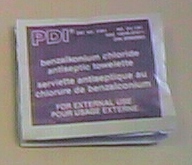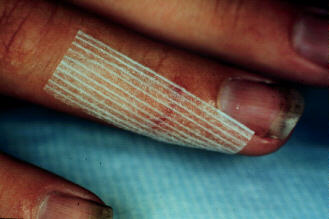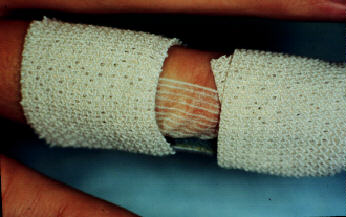
How to Clean a Wound During First Aid
By an eHow Contributor
All open wounds are contaminated to some extent and are potential sites for infection. The best way to prevent infection is to remove all debris from the wound and discourage further growth of bacteria.
Preparation
Irrigation and Scrubbing
Read
more: How to Clean a Wound During First Aid | eHow.com
Some more notes:
Most important step is wound irrigation with fluid under pressure to
remove bacteria and contamination
30-60-cc syringe to push fluid through a 19-gauge catheter with maximal
hand pressure.
minimum of 250cc or 60cc / cm wound length
OR high volume of fluid under low pressure may be good
Povidone-Iodine Solution 10% (Betadine) is tissue toxic and did not
reduce infection
NEVER use hydrogen peroxide - it is also tissue toxic
Tap water: low cost, available
Tap water is a safe and effective solution for cleaning recent wounds
requiring closure and is the treatment of choice
Ideal time frame, within 8-12 hours for penetrating injury of the extremity,
6-10 hours for wounds of the extremities and up to 10-12 hours for
face and scalp
Sutures: percutaneous w/absorbable for low-to-medium wounds. Interrupted
same as others
Glue: Faster repair time, less painful, doesn't require removal, best
for facial lacerations in children
Glue best choice for short (< 6-8 cm), low tension (<0.5 cm gap),
clean edged, straight to curviliean not crossing joints of creases
Don't glue: stellate wounds, bites, punctures, crush wounds, mucosal
surfaces, axillae and perineum (high-moisture areas), hands, feet and joints
(unless kept dry and immobilized)
Steri-Strips: least reactive, lowest tensile strength, may require
benzoin, avoid in hairy and wet areas.
Steri-strips similar to closure w/glue
For head wounds, can tie hair to close wound! Twist hair on either
side and tie twists together.
Lacerations 10 cm or less and hair longer than 3 cm
Delayed Primary Closure recommended for contaminated wounds: Clean and
debride then
separate wound edges with gauze, and apply bulky dressing.
Need antibiotics for open joint or wound fractures, human, dog and
cat bites, intraoral lacerations, immnocompromised, heavily contaminated
wounds (e.g. feces, etc.)
Bacitracin or Neosporin best for postclosure
Sterile gloves have no advantage over nonsterile.
Small, simple hand lacerations (<2cm don't require primary closure)
Treat a laceration at home only if it's small, shallow, in an "unimportant
area," and the skin along the laceration matches up perfectly (and remains
together when undisturbed). In general, you should see the doctor for lacerations
where:
the cut is gaping.
the edges can be pulled more than 1/8 inch
apart with traction on nearby skin.
the cut is over a knuckle.
the cut is on the face or genitals
the cut might be contaminated with foreign
material.
the cut was caused by human or animal teeth.
there is numbness, deep pain, or inability
to move a part fully.
 |
Clean the cut. Benzalkonium chloride towelettes or Betadine prep pads can be used as an antiseptic. After cleaning, dry the skin. Keep the cut closed with direct pressure until the bleeding is stopped and it tends to remain closed by itself. |
Butterfly bandages and Steri-strips will hold without special preparation.
But it you think the wound may be prone to opening (in which case I really
recommend you go get stitches) and are determined to treat it yourself,
you may want to prepare the skin so strips will stick longer and tighter.
If you have Benzoin (a "stick-um" liquid), apply a thin coating on each
side of the cut and allow it to dry completely. Nail polish remover can
also be used to remove skin oils for a more secure "hold," but you must
be careful not to get it in the cut.
| To secure the closure, press the skin edges together. (They
should fit perfectly. If not, you have a problem.) Attach the butterfly
or Steri to one side and pull gently across the cut. You can use your other
hand to hold the wound closed.
When you see the skin puckering slightly and the wound looks tightly closed, push the second side of the butterfly down. For a longer cut, you may need three or four butterflies or Steris. |
 |
 |
When the wound seems closed, move the extremity around
to be sure the wound stays closed and the tapes won't pull off.
Now pad the wound with a non-stick pad, then gauze placed directly over top. If necessary, trim the pad to fit. If the wound is on an extremity, bind the dressing with a kling wrap. Secure the bandage with Coban wrap or tape. See the section on wound dressings. |
If you decide to treat a sharp laceration over a moving surface (such
as knee, elbow, or knuckle), you need to provide protection against motion
for the first few days. Think about what you'll do during the 7-10 days'
healing time -- and consider stitches.
 |
The wound has been cleaned. Benzoin has been placed and
allowed to dry completely. Now a Steri-Strip has been placed.
Steri-Strips or a butterfly bandage can secure a closure -- either to help you ride out with a cut that will need stitches, or as permanent treatment for minor, sharp cuts. |
| Steri-Strips don't stretch. But the skin over this knuckle
will. The joint must be kept from moving until the early healing is complete.
Here a short splint of aluminum with foam has been placed and taped.
Cuts over moving areas must be secured, so the moving skin doesn't pull the cut back open. |
 |
If you're treating the cut at home, leave the butterflies or Steris until they peel off on their own. Keep the wound covered with a dry dressing and keep it clean. Avoid bumping the area. It takes between 10 and 14 days before the cut is strong enough for routine duty without a dressing.
Watch for:
See the doctor if there is redness around the wound, red streaks, swelling,
drainage, fever, tender bumps in the groin or armpit upsteam from the wound,
or an unexplained increase in pain or tenderness. See
section on infection.
Normal isotonic saline is generally favored to cleanse wounds. Two investigators from Australia studied the Cochrane Controlled Trials Register and 4 other major databases to report in 2008[1] on 11 randomized and quasi-randomized controlled trials that compared rates of infection and healing with water and saline, as well as no cleansing. Tap water was statistically more effective than saline at reducing infection rates in adults with acute wounds and no different than saline in children. No statistically significant differences in infection rates were seen when wounds were cleansed with tap water or not cleansed at all. So you have lots of choices when confronted with an acute wound.
*******************************
Or you could be sensible and equip your self with a quart Mason jar
and a measuring teaspoon and a box of (non-iodized if you're the nervous
type)salt. Stir this combo up (1 tsp/qt) and you'll have yourself pretty
close to God's designated 385 mOsm/L. Wash away, and preserve those cells
for healing.
*******************************
It wasn't clear to me whether the tap water was running water or just
tap water in a bowl or on a pad. Certainly one advantage to using running
tap water is the old "the solution to pollution is dilution" paradigm and
I suspect we dilute more effectively this way than with the standard of
irrigating with syringes or other irrigating devices and normal saline.
(Do I really think my ED colleagues take the time to irrigate with "100
cc's of normal saline"on the wounds they suture--generally no.) I've been
using running tap water (liberally) with soap and towel drying for both
initial cleansing of most wounds with some irrigation of suturable wounds
with saline primarily to get the soap out! Wounds near the eye and those
which are bleeding profusely are exceptions. Generally I find soaking wounds
to be subptimal as a sole method of cleansing because it often leaves debris
behind, doesn;t get into the depth of many wounds or under flaps.
On follow ups, I use only running tap water and soap and towel drying. Providing they can tolerate the procedure I let my patients do even initial cleansing themselves. It saves my staff time and gives us an opportunity to observe and educate them on wound care. I'm so glad I can refer to this study when my colleagues or assistants look askance because they think I'm practicing suboptimal care.
*******************************
HYPERTONIC SALINE WET TO DRY WORKS WELL & HELPS DEBRIDE
Don't know why hypertonic saline approx 2.5-5% is not tested along
with NS...I've used it many times in surgical wounds where thers a superficial
infection & skin separation. Using the hypertonic saline in a wet to
dry dressing fashion & changing it 2-3 times a day keeps the area remarkably
clean & doesn't seem to impair granulation the way Betadine has been
reported to do. The salt (iodized table is fine) draws out edema &
prevents bacterial growth. Works great on kids skin wounds & pustules
of various sorts too.
The only reason hypertonic saline is not tested
against Commercial antibacterial salves etc , is that there's no money
in it & it beats most of them I believe. Google hypertonic saline...
there's some interesting info there... one report even used 5% saline ointment
in a subacute to chonic eye condition. And if you want a non-addicting
sinus cleanser when you have sinusitis for any reason, fill you nasal passages
with hypertonic saline sol'n, I use 1/4 teaspoon silt per 4 oz H20.. but
you can look up a more precise measurement. When you have a cold, do it
at bedtime for a much better sleep. With your head tipped back over a cushioned
tub edge you can use a mini baster from Walmart or just pour it in your
nostrils... hold it there as long as you can, breathing though your mouth.(60
seconds is fine)..snort it into the toilet & repeat once more. With
kids you can get empty atomizers at Walgreens & atomize the solution
but it only works about half as well. B.H. CROWELL, M.D. ret